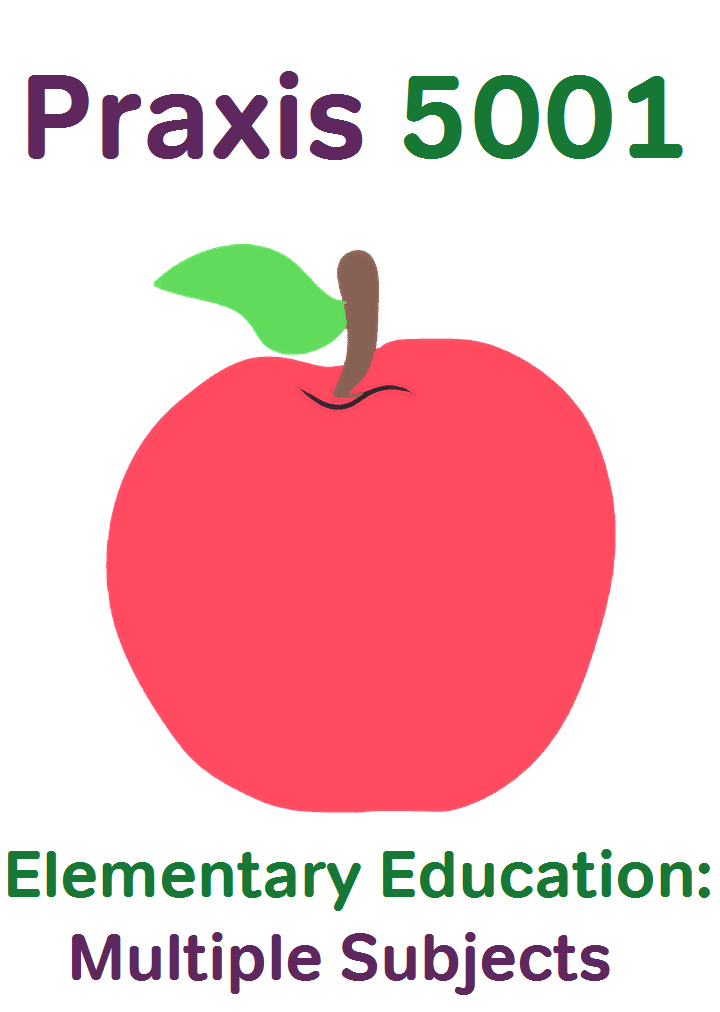
I’ve been getting a lot of student questions on scores for Praxis II, test 5001 (Elementary Education: Multiple Subjects). And I can understand why!
The scoring system for Praxis 5001 is especially confusing because this exam contains four subtests. Moreover, state licensing boards have different score requirements for every subtest in 5001! To make matters even more complex, each subtest has subsections within it.
Consequently, the score report you see in the test center will likely be confusing. Your Praxis 5001 raw score report usually gives you scores by subsection rather than subtest. I say “usually,” because the Praxis is frustratingly inconsistent with the formats of the unofficial score reports they issue in the test center. On occasion, I’ve talked to students who get a really in-depth score report that includes unofficial scaled scores for each subtest. But you can’t count on getting something that “user friendly,” and you’ll probably just get subsection numbers.
What are the four subtests in Praxis 5001, and what subsections are in each subtest?
Before we really discuss how scoring works for the Praxis Subject Assessment for Elementary Education: Multiple Subjects, let’s take a good look at each subtest.
The 4 subtests in this exam all have their own additional 500X Praxis II code numbers. And each subtest has its own unique subsections and a different total amount of questions. Understanding the differences in the subtests is key to understanding scoring for the overall 5001 exam. So read the following descriptions carefully:
- READING AND LANGUAGE ARTS SUBTEST
Praxis code number: 5002
Total number of questions: 80- Reading and Language Arts, Subsection 1: Reading
Number of questions: 38
Score weight: worth 47% of the Reading and Language Arts subtest score - Reading and Language Arts, Subsection 2: Writing, Speaking, and Listening
Number of questions: 42
Score “weight”: worth 53% of the Reading and Language Arts subtest score
- Reading and Language Arts, Subsection 1: Reading
- MATHEMATICS SUBTEST
Praxis code number: 5003
Total number of questions: 50-
- Mathematics, Subsection 1: Numbers and Operations
Number of questions: 20
Score weight: worth 40% of the Mathematics subtest score - Mathematics, Subsection 2: Algebraic Thinking
Number of questions: 15
Score weight: worth 30% of the Mathematics subtest score - Mathematics, Subsection 3: Geometry and Measurement, Data, Statistics and Probability
Number of questions: 15
Score weight: worth 30% of the Mathematics subtest score
- Mathematics, Subsection 1: Numbers and Operations
-
- SOCIAL STUDIES SUBTEST
Praxis code number: 5004
Total number of questions: 60- Social Studies, Subsection 1: United States History, Government, and Citizenship
Number of questions: 27
Score weight: worth 45% of the Social Studies subtest score - Social Studies, Subsection 2: Geography, Anthropology, and Sociology
Number of questions: 18
Score weight: worth 30% of the Social Studies subtest score - Social Studies, Subsection 3: World History and Economics
Number of questions: 15
Score weight: worth 25% of the Social Studies subtest score
- Social Studies, Subsection 1: United States History, Government, and Citizenship
- SCIENCE SUBTEST
Praxis code number: 5005
Total number of questions: 55- Science, Subsection 1: Earth Science
Number of questions: 17 – 18
Score weight: worth 33% of the Science subtest score - Science, Subsection 2: Life Science
Number of questions: 18 – 19
Score “weight”: worth 33% of the Science subtest score - Science, Subsection 3: Physical Science
Number of questions: 18 – 19
Score “weight”: worth 33% of the Science subtest score
- Science, Subsection 1: Earth Science
Understanding Subsection Raw Scores
As I mentioned at the beginning of this article, each of the four subtests (Reading & Language Arts 5002, Mathematics 5003, Social Studies 5004, Science 5005), gets its own individual scaled score. (A scaled Praxis II score has a range of 100-200. Both your official and unofficial scores will be in this range.)
As I mentioned, on test day you’ll probably only see the raw scores for your subtests once you finish the exam. These raw scores will show you how many answers you got right on each subtest, but won’t convert your number of correct answers into a scaled score.
To make things even more complicated, raw score reports for Praxis 5001 usually show your total number of correct answers by subsection, not by subtest. So for instance, your score report for the science subtest might tell you that you got 15 questions right in the Earth Science subsection, 14 right in Life Science, and 13 right in Physical science. But what the score report won’t show is your total correct answers for the Science Subtest as a whole. What a headache!
Fortunately, you can use the subsection raw scores to calculate your subtest scaled scores pretty easily. It’s just a matter of knowing which calculations to make.
How to Convert Subsection Raw Scores into Subtest Scaled Scores
Imagine you’ve just finished your Praxis 5001, and further imagine you were particularly worried about how you did in the Science Subtest (5005). We’ll say that you need to get a 175 on this subtest, and you’re not sure if you made it. Next, imagine that when you look at your unofficial score report in the test center, and this is what it shows you for Science 5005:
- Earth Science: 16
- Life Science: 15
- Physical Science: 14
How on earth can you go from that subsection raw score data to an estimated scaled score for the whole subtest? How can you figure out if you passed this subtest or not? Don’t worry… I’m about to tell you how you can estimate your official score on any Praxis 5001 subtest. It’s a four-step process, but rest assured that the math is not that complicated.
Converting Subsection Raw Scores into Subtest Scaled Scores
First off, don’t worry too much about the percentage of the subtest that each subsection is worth. Subsection weights are always proportional to the actual number of questions in the subsection. In the Reading and Language Arts subtest, for instance, 38 Reading subsection questions really roughly 47% of the 80 total questions on the subtest. That’s why this subsection is worth 47% of your score. Similarly, the remaining 42 questions in the Writing/ Listening/Speaking subtest is proportional to 53% of 80.
So there are no special, disproportional point weights for any subsections. Because of this, if you add up the total number of answers you got right in each subsection, you’ll have the correct raw score for the whole subtest. This brings us to our first step–and the rest of the steps–for converting your subsection raw scores into a scaled score. (Your scaled score is an estimate of your official score.)
- Step 1: To get the raw score for the whole subtest, add together the raw points from each subsection of your subtest.
- Example: In the Science subtest raw scores below, you add 16+15+14 to get a total score of 45.
Earth Science: 16
Life Science: 15
Physical Science: 14
- Example: In the Science subtest raw scores below, you add 16+15+14 to get a total score of 45.
- Step 2: Turn your total number of raw points into a ratio of correct answers to total number of answers.
- Example: The Science subtest has 55 questions total. If your raw score in the Science subtest is 45, you answered 45 out of 55 questions correctly. This is a raw score ratio of 45/55.
- Step 3: Convert your ratio raw score into a percentage. (This is the percentage of questions you answered correctly in the whole subtest.)
- Example: 45/55 = 0.82. Expressed as a percent, 0.82 becomes 82%
- Step 4: Take the number of your raw score percentage (the percent of answers you got right), and add 100 to that number. This is your approximate scaled score for the subtest. This number should correspond roughly to the official score you’ll get.
- Example: If you got 82% of your questions right on the Praxis 5001 Science subtest, you would add 100 to 82 to estimate your official scaled score. 100 + 82= 182.
And you’ve done it! Now, remember earlier in this post, when I asked you to imagine you needed 175? 182 is comfortably higher than 175. So congratulations, you can imagine you passed the Science subtest! Better yet, this 4-step score calculation process works for the subtests on the real Praxis 5001 you took, too.
Will Your official score for the Praxis 5001 subtests really be the same as your estimate?
I can answer this question with a firm “probably.” However, there’s always a chance your official Praxis 5001 subtest scores will be adjusted from your estimation.
Sometimes the scores on the subtests are adjusted for the relative point weight of individual questions. If a question prompts you to select multiple answers or seems to test more than one important concept, it may be worth more than one point. So the correlation between your number of right answers and your scaled score isn’t always exact.
There’s also a possibility that a subtest score could be adjusted for the relative difficulty of the questions. In other words, if you correctly answer a question that most test-takers get wrong, you may get additional points. However, this kind of “difficulty adjustment” is said to be pretty rare on the Praxis 5001.
How Do You Calculate your Overall Score for the Whole Praxis 5001 Exam?
You don’t. The Praxis only issues scores on the subtests for Praxis 5001 (Elementary Education: Multiple Subjects). The “5001” number is used only for the purposes of registration. If you register for the Praxis 5001, then you are able to register for all four subtests at once. (This is $70 cheaper than registering for each subtest individually.) But for scoring purposes, there is no Praxis 5001. There are just the separately scored Praxis 5002, 5003, 5004, and 5005 tests. Simple enough, eh? 😉





Leave a Reply